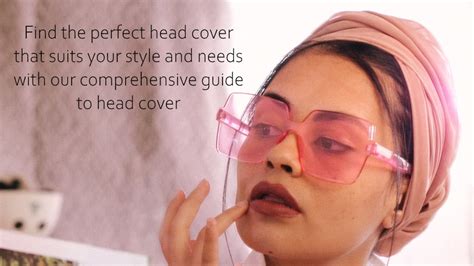Introduction
Head coverings have been an integral part of women’s fashion and culture for centuries. Whether worn for religious, cultural, or personal reasons, head covers offer a wide range of benefits and styles. This comprehensive guide will delve into the various types of head covers for women, exploring their history, benefits, and potential applications.

Types of Head Covers
Hijabs:
- Definition: A rectangular or square piece of fabric worn by Muslim women to cover their heads and necks.
- Benefits: Privacy, modesty, religious observance.
Niqabs:
- Definition: A full-face veil that covers all but the eyes.
- Benefits: Privacy, protection from the elements.
Burqas:
- Definition: A full-body covering that leaves only the eyes exposed.
- Benefits: Privacy, seclusion, religious observance.
Snoods:
- Definition: A tight-fitting cap that covers the hair.
- Benefits: Warmth, protection from the elements, hair management.
Berets:
- Definition: A soft, round cap with a flat top.
- Benefits: Style, warmth, protection from the elements.
Headbands:
- Definition: A narrow band of fabric worn around the head.
- Benefits: Style, hair management, sweat absorption.
Turbans:
- Definition: A long piece of fabric wrapped around the head.
- Benefits: Style, versatility, protection from the elements.
Benefits of Head Covers
Head covers provide women with numerous benefits, including:
- Religious observance: Head coverings hold religious significance for many women, such as hijabs for Muslims and nuns for Catholics.
- Privacy: Head covers can offer privacy and seclusion, especially in crowded or public spaces.
- Modesty: Head coverings can promote modesty and discretion, as they conceal certain areas of the body.
- Warmth: Head covers can provide warmth in cold weather by protecting the head, ears, and neck.
- Protection from the elements: Head covers can shield the hair and skin from the sun, wind, and rain.
- Hair management: Head covers can help manage hair, especially for women with thick or unruly hair.
- Style: Head covers can add a touch of style and elegance to any outfit.
Applications of Head Covers
Head covers have a wide range of applications, including:
- Religious rituals and ceremonies: Head coverings are essential for many religious practices and rituals, such as prayers and special occasions.
- Cultural events: Head coverings are often worn as a sign of respect or cultural heritage, such as at weddings or festivals.
- Everyday wear: Head covers can be worn as part of everyday clothing for style, warmth, or protection.
- Protection from pollution and dust: Head covers can help prevent hair damage from air pollution and dust, especially in urban areas.
- Hair loss: Head covers can provide comfort and confidence for women experiencing hair loss due to medical conditions or chemotherapy.
- Fashion statement: Head covers have become a popular fashion statement, with designers offering a wide range of stylish and innovative designs.
Market Trends and Statistics
The head cover market is growing globally, driven by increasing awareness of religious and cultural diversity, fashion trends, and health concerns.
- According to a report by the World Economic Forum, the global Muslim population is expected to reach 2.2 billion by 2030, creating a significant demand for hijabs and other head covers.
- A study by the University of California, Berkeley found that the head cover market in the United States is estimated to be worth over $500 million annually.
- Research by Euromonitor International shows that the demand for head covers is increasing in non-Muslim countries as well, driven by fashion trends and the desire for hair protection.
Future Applications and Innovations
The future of head covers holds exciting possibilities for innovation and new applications.
- Smart textiles: Head covers with integrated sensors and connectivity could monitor health parameters and provide personalized comfort and protection.
- Virtual reality (VR) integration: Head covers could be integrated with VR technology to enhance immersive experiences and provide visual protection.
- Medical applications: Head covers could be developed to provide therapeutic benefits, such as reducing stress or improving sleep quality.
- Customization and personalization: Head covers could be customized to meet individual needs and preferences, with personalized designs and functionality.
- Eco-friendly materials: Head covers made from sustainable materials could reduce environmental impact and appeal to conscious consumers.
How to Choose the Right Head Cover
Choosing the right head cover depends on several factors, including:
- Purpose: Consider the intended use of the head cover, such as religious observance, fashion, or protection.
- Material: Head covers are made from various materials, such as cotton, silk, wool, and polyester, each with its own benefits and drawbacks.
- Style: Head covers come in a wide range of styles, from traditional to modern, so choose one that complements your personal taste and style.
- Fit: Ensure that the head cover fits comfortably and securely without causing discomfort.
- Color: Choose a color that complements your wardrobe and matches the occasion.
Tips for Wearing Head Covers
- Experiment with different styles: Explore various head cover styles to find what suits you best.
- Accessorize: Use accessories like pins, scarves, and jewelry to enhance your head cover look.
- Practice tying methods: Learn different ways to tie head covers to achieve the desired style and fit.
- Be confident: Wear your head cover with confidence and embrace the unique style it brings to your wardrobe.
- Seek advice: Consult with a religious scholar or cultural expert for guidance on appropriate head cover practices.
Conclusion
Head covers for women offer a diverse range of benefits and applications. From religious observance to fashion statements and everyday comfort, head covers have become an integral part of women’s lives worldwide. As the head cover market continues to grow, innovation and new applications will shape the future of this essential accessory. By understanding the types, benefits, and applications of head covers, women can make informed and empowering decisions about their choices, embracing the style, modesty, and protection they provide.
